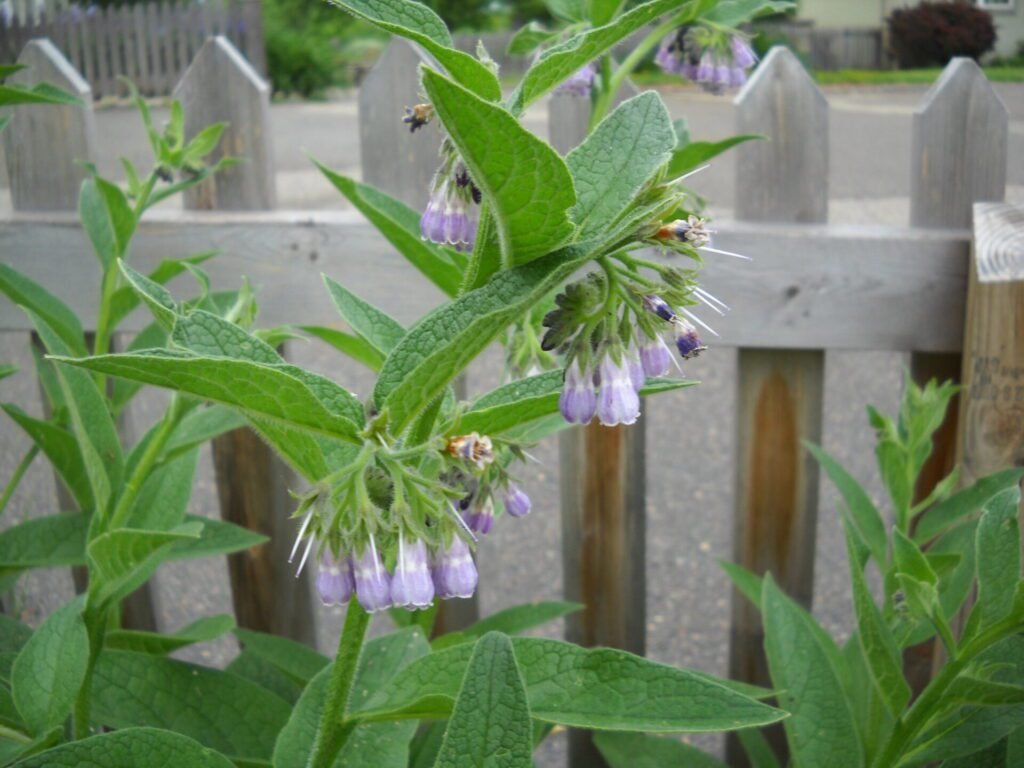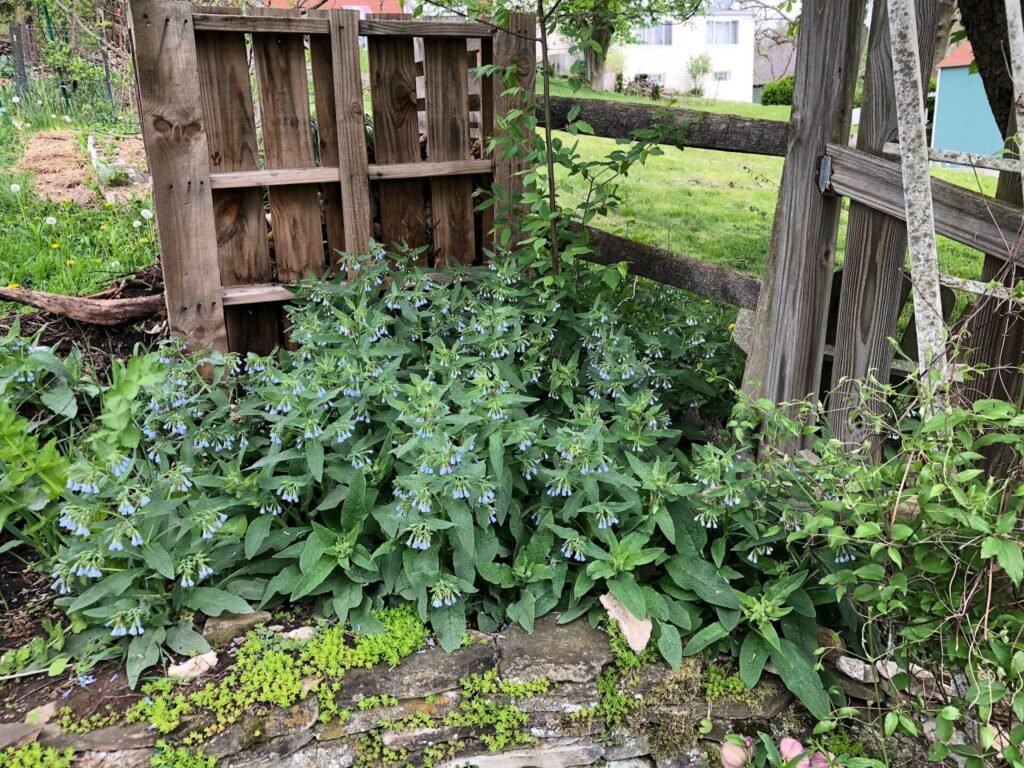Welcome to Comfrey Gardening!
Hello, green thumbs and herbal enthusiasts! Ready to add a touch of healing green to your garden? Comfrey, a plant celebrated for its medicinal qualities, is a fantastic choice for both novice and experienced gardeners. This guide is crafted to help you navigate the journey of growing Comfrey, covering everything from planting seeds to enjoying the lush growth of this beneficial herb. Let’s embark on this green adventure together!


What Is Comfrey? A Brief Overview
Before we begin, let’s revisit what Comfrey is. Known for its medicinal properties and use as a natural fertilizer, Comfrey is a versatile addition to any garden. For more on its benefits, refer to our ‘What is Comfrey? A Complete Guide to Benefits, Uses, and Advice‘ article.

Selecting the Right Comfrey Variety
| Variety | Characteristics | Best For | Notes |
|---|---|---|---|
| Common Comfrey (Symphytum officinale) | Fast-growing, can spread via seeds | Medicinal use, larger gardens | Ideal for making salves and poultices |
| Bocking 14 | Sterile hybrid, non-invasive | Controlled growth, smaller spaces | Doesn’t spread easily, less maintenance |
Choose based on your space availability and how you plan to use Comfrey in your garden.
Preparing for Planting
- Location Tips: Comfrey prefers a sunny or partially shaded spot. It’s adaptable but thrives in moist, well-drained soil.
- Soil Preparation: Work some compost or organic matter into your soil before planting. Comfrey grows well in rich soil but can adapt to poorer soils too.
- Sourcing Comfrey: You can start Comfrey from seeds, root cuttings, or young plants. Root cuttings are the easiest and most common method.

Planting and Caring for Comfrey
- Planting Process: If you’re using root cuttings, plant them about 2 inches deep and 2-3 feet apart. Water them thoroughly after planting.
- Watering Needs: Comfrey doesn’t require a lot of water. Water it regularly until it’s established, then it will be fairly drought-tolerant.
- Fertilizing: Comfrey generally doesn’t need much fertilizing, especially if your soil is already rich.
Understood, let’s streamline the table to make it more concise and visually appealing:
While growing Comfrey is generally straightforward, you may encounter a few common issues. Here’s a concise table with quick solutions:
| Issue | Solution | Quick Tip |
|---|---|---|
| Overgrowth | Regularly harvest leaves | Keeps the plant manageable and healthy |
| Pests | Use natural pest control | Comfrey is robust, but watch for slugs |
| Rotting | Ensure good soil drainage | Prevents root rot in damp conditions |
Addressing these challenges early can help you maintain a healthy and thriving Comfrey plant in your garden.

Harvesting and Utilizing Your Comfrey
Once your Comfrey plants are thriving, you’ll want to know the best way to harvest and use them. Here’s a guide to help you make the most of your Comfrey:
When to Harvest Comfrey:
- The ideal time for your first Comfrey harvest is in its second growing season. This gives the plant enough time to establish itself.
- Look for when the leaves are large and lush, but before the plant starts flowering. This is when the leaves are most potent.
How to Harvest Comfrey:
- Use garden shears or scissors to cut the leaves. Aim to cut close to the base of the plant, but be careful not to damage the crown.
- Wear gloves if you have sensitive skin, as Comfrey leaves can be a bit prickly.
How Often to Harvest:
- You can typically harvest Comfrey several times during the growing season. After the first cutting, the plant will regrow, allowing for multiple harvests.
Using Your Harvested Comfrey:
- Topical Remedies: Comfrey leaves are excellent for making salves, poultices, and oils for skin care and muscle aches. Dry the leaves and infuse them into your choice of oil to create a healing balm.
- Garden Compost: Comfrey leaves are high in nitrogen and make great ‘green’ material for your compost pile. They break down quickly and enrich the compost with essential nutrients.
- Liquid Fertilizer: You can also steep Comfrey leaves in water to create a nutrient-rich liquid fertilizer for your garden plants.
Harvesting and using Comfrey is incredibly rewarding. Not only do you get to enjoy the fruits of your labor, but you also gain valuable natural remedies and garden supplements.

Growing Comfrey? Watch This!
If you’re wondering how to get those Comfrey plants flourishing, check out these cool video guides. They’re packed with easy-to-follow advice that’ll give you the green thumb you need. Grab a cup of tea, kick back, and let’s start growing!
- How To Grow Comfrey From Seed, Crowns, and Root Cuttings
- How to Propagate, Grow and Use Comfrey
Frequently Asked Questions About Growing Comfrey
Growing Comfrey can bring up many questions, especially for beginners. Here are detailed answers to some of the most common queries:
Comfrey prefers a sunny or partially shaded spot. It’s quite adaptable but grows best with at least a few hours of sunlight each day.
Water your Comfrey plants regularly until they’re established. They’re fairly drought-tolerant once mature, so you can reduce the frequency of watering.
Comfrey is quite hardy and can grow in a range of soil types, including poor soils. However, it thrives in well-drained, fertile soil. Adding compost can improve growth.
Comfrey is a fast-growing plant. Once established, you’ll notice significant growth, especially in the spring and summer months.
Generally, Comfrey doesn’t require much additional fertilization, especially if planted in rich, organic soil. You can add compost as a natural fertilizer if needed.
To control its spread, consider planting a non-invasive variety like ‘Bocking 14’. Regularly harvesting the leaves also helps keep it in check.
Yes, Comfrey can be grown in large containers. Ensure there’s enough room for root growth and provide adequate drainage.
The ideal time to plant Comfrey is in the early spring, after the risk of frost has passed.
Comfrey is generally robust, but keep an eye out for slugs and snails, especially on young plants. Root rot can occur in waterlogged conditions, so good drainage is essential.
Use sharp scissors or shears to cut the leaves. Avoid cutting into the crown of the plant. Regular harvesting is actually beneficial for Comfrey, encouraging new growth.
I hope these answers have shed light on the most common questions about growing Comfrey. Remember, gardening is a learning journey, and growing Comfrey can be a particularly rewarding part of that adventure. With patience and care, you’ll soon be able to enjoy the benefits of this remarkable herb in your own garden. Happy gardening, and feel free to explore more, experiment, and share your Comfrey-growing experiences!

